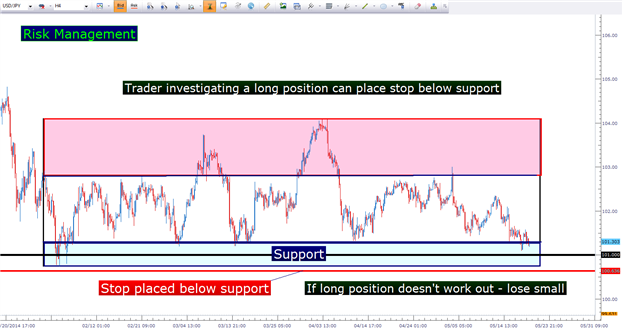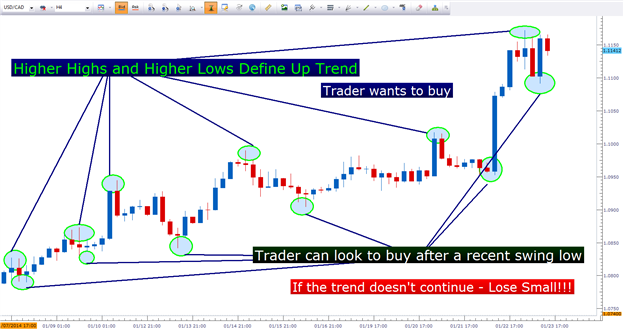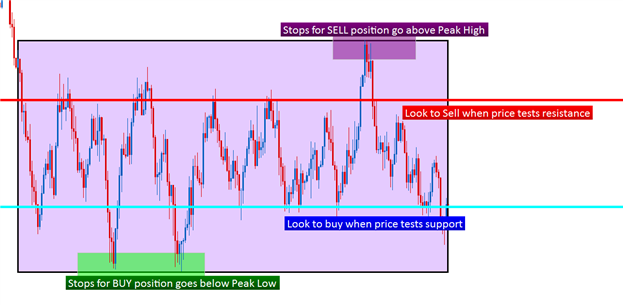Money management in Forex trading is one of the most important problems of new and even advanced forex traders. Almost everybody can find a good
trading system that can be profitable but something that causes traders to lose and be negative at the end of the month, is lack of a proper money management strategy and
discipline. Although money management is so important and critical, it is still very easy to follow.
Forex money management have several different aspects and stages and should be started from the very first stages of your live forex trading business which is opening your live
trading account. We have a very simple rule that says “Never risk more than 2% of your money.” Most traders think that this rule should only be applied after having a live trading account and while they trade, but this is not true. This rule should be considered even when you want to open your
live account. Lets say you have already practiced and
demotraded enough and you feel confident enough to open your live account. And lets say you have a $20,000 saving. Would you open a $20,000 live account? Well, you can do that but what if you lose this money for any reason? For example your broker becomes bankrupt and closes the company and never pays your money back. Or you take a 20 lots position by
mistake and you forget to set the stop loss. It goes against you for 100
pips and wipes out your account. You will not be able to start over, at least for a long time that you save some money. And this initial failure may have a bad impact on you and you may not think about forex trading anymore and you will lose the opportunity for good.
If $20,000 is the only money you have, you should open a $400 account, specially if that account will be your first live account. Or a $1000 account maximum, if you are confident enough that you have had enough practice and you know how to trade.
Therefore money management should be considered even before live trading and when you want to open your live account.
The second stage is when you want to choose the leverage of your account. Nowadays you can have even a 1:500 leverage but this leverage is too big for new traders and even experienced traders try to avoid it. A 1:200 leverage is acceptable. I do not want to talk about leverage in this article because this article has to be focused on money management but briefly, leverage is the facility that your broker gives you to enable you to manage bigger amount of money using a smaller amount of money. For example if a broker gives you a 1:1 leverage account, then when you want to buy 100,000 USD against Japanese Yen, you should have 100,000 USD in your account at least. But if a broker offers a 1:100 leverage, then you only need to have $1,000 to buy a 100,000 USD and so with a leverage of 1:500 you only need to have $200 to buy 100,000 USD.
So why having a big leverage like 1:500 is dangerous? Because you can trade a huge amount of money and if your trade goes against you, you lose all your money very easily. When you have a $400 account with a 1:500 leverage, if you buy 100,000 USD against JPY and it goes against you for 40 pips only, you will lose all your money and you can not trade anymore. Whereas if your
account leverage was 1:100, you could buy maximum $20,000. If you trade $20,000 with a 40 pips stop loss and your trade hits your stop loss, you lose $80 but a 40 pips stop loss with a 100,000 USD position equals to $400. To risk $400, you should have a $20,000 account, not a $400 account because we are supposed to risk only 2% of our capital at any time, not 100% of it.
The third place that you have to consider money management, is where you want to take a position. Again, we should not risk more than 2% of our capital. This rule should be applied to the positions we take too. This is the most important stage of money management, which is very easy to apply. You just need to consider it and not to ignore it. Now the question is how you can trade while you are not risking more than 2% of the money you have in your account (your
account balance).
Before I answer this question and before I teach you how to calculate your positions in the way that you don’t risk more 2% with any trade, I want to tell you something which is even more important:
Stop Loss
Let me tell you something frankly and seriously. If you don’t set a proper stop loss for your trades, if you hate setting stop loss and if you set stop loss but you move it when you see it is about to be triggered, you will never become a forex trader BECAUSE you lose all the money you have and you will not be able to trade anymore. Do yourself and your money a favor: Stay away from forex market if you don’t like to have stop loss for your trades. I can not emphasize on the importance of stop loss more than this.
Setting a proper stop loss for each trade, is a different story. Some traders always consider a constant number of pips for their stop loss positions but this is not correct. Stop loss value can be different from
time frame to time frame, currency pair to current pair and trade setup to trade setup. Stop loss that I choose for a position which is taken based on a trade setup on
daily chart, has to be much bigger than the stop loss I have, when I trade using a 15min chart. Accordingly the stop loss I have when I trade EUR-GBP is different than the stop loss I set for
GBP-JPY.
Ok! Lets get back to our money management discussion. So the third stage of money management is when you want to take a position. The rule says never risk more than 2% of your capital in each trade. It means if you take a position and it goes against you and triggers your stop loss, you should only lose 2% of your account balance. For example if you have a $10,000 account, you should only risk $200 in each trade. No matter what position you take and how big your stop loss is in different positions. You should choose the “
position size” in the way that if your stop loss becomes triggered in any position, you lose 2% of your account. For example if you find a trade setup on
EUR-USD daily chart that has to have a 150 pips stop loss. This 150 pips should equal to $200. Accordingly, a 20 pips stop loss on 5min chart should also equals to $200 which is 2% of your account. Easy to understand so far, right?

Before I show you how you can calculate your position size, let me tell you another thing. If a position goes against you and you feel stressed out and you down on your knees and start praying and begging
God to return the market and you can get out at breakeven, it means: You have traded with the money that
you can not afford to lose and if you lose it, you will be in trouble. And you have taken too much risk in your trade and you have not followed money management rules. And you have not set a stop loss and your account is so close to become margin called. If you trade like this, you should know that this is not trading. It is something else. And if by any chance, market returns and you can get out at breakeven in one trade, you will be trapped in another trade and you will lose all your money. But if you follow money management rules and you don’t risk more than 2% of you money in each trade and you set a proper stop loss, when your stop loss becomes triggered you will say, “Well! this is part of the game too. Not all my positions are supposed to hit the target.”
Now I show you how easy it is to calculate your position size. Lets say you have a $10,000 account and you have found a trade setup with EUR-USD which has to have a 100 pips stop loss. This 100 pips stop loss should equal to 2% of your capital, based on money management rule that says you should not risk more than 2% of your capital in each trade.
2% of $10,000 is $200:
$10,000 x 0.02 = $200
Now tell me if 100 pips should equal to $200, what value each
pip should have? That is right. Each pip should equal to $2:
$200 / 100 pips = $2
So to risk only 2% of your money in this trade, your position size (the amount of money that you trade) should be chosen in the way that each pip equals $2.
Now the question is how much EUR-USD you should trade if you want each pip to equal $2?
This question refers to
pip value of each currency pair. One lot is 100,000 units of a currency in forex world. For example when you buy one lot EUR-USD, it means you have bought 100,000 Euro against USD. If you buy 0.1 lot EUR-USD, it means you have bought 10,000 Euro against USD and so on…
Each currency pair has a different pip value. Pip value can be calculated but you don’t have to learn how to do it because it is a little complicated with some
currency pairs. Also, you don’t have to know the exact pip value of each currency pair to calculate your position size. You only need to know that one lot EUR-USD,
GBP-USD,
USD-JPY and
USD-CHF has a $10 pip value (sometimes a little higher and sometimes a little lower). Pip value of one lot GBP-JPY, EUR-JPY,
AUD-USDand
USD-CAD is almost $10 too. EUR-GBP has the highest pip value among currency pairs. It is almost twice of the pip value of EUR-USD. And pip value of
exotic currency pairs like USD-DKK, USD-SEK and USD-NOK is about 0.1 pip value of EUR-USD. Pip value of each current pair, changes with the price change but it doesn’t change too much to affect our position size calculation. For example pip value of one lot EUR-USD, sometimes is a little higher and sometimes a little lower than $10.
Don’t worry. You don’t have to memorize them. I will give you a
calculator at the end of this article that can easily calculates your position size. I will also give you a
pip value calculator. But before that, I just want to make sure that you understand how to calculate your position size manually.
Back to our question, how much EUR-USD you should trade that each pip equals $2:
It is now very easy to answer. Each pip equals $10 when you trade one lot EUR-USD. So you should trade 0.2 lot if you want each pip of your position to equal $2. It can be calculated through a simple equation:
What if you had a 100,000 USD account and you had found a EUR-USD trade setup which its stop loss had to be 200 pips?
Now you can answer it right away: 2% of a 100,000 USD account is $2,000. When a 200 pips stop loss has to equal $2000, each pip value will be $10:
$2000 / 200 = $10
So the pip value of your trade should be $10 and your position should be a one lot position.
Another example: If you had a $20,000 account and you had found a EUR-GBP trade setup with a 90 pips stop loss, how much your position would have to be not to risk more than 2% of your capital?
Answer: 2% of a $20,000 account is $400. When a 90 pips stop loss should equal $400, the pip value of your position should be $4.4:
$400 / 90 = $4.4
One lot EUR-GBP has a $20 pip value. So you should take a 0.22 lot position:
$4.4 / $20 = 0.22 lot
Most traders say, your target size should be at least the same size as your stop loss, if not bigger. But choosing the target is also dependent on the trade setup you have found. When you have found a long position, you should be able to find the next resistance level that may stop the price from going up. That level will be your target. Accordingly, when you find a short trade setup, you should be able to find the next support level that may prevent the price from going down. That level will be your target. Then if you see your target will be smaller than your stop loss, you should ignore that position and you should wait for another trade setup.
Another strategy that helps you to make more profit and protect the profit you make, is splitting your position into two or even three parts and have a different target for each part. For example you find a trade setup and based on risk calculation, you have to take a 2 lots position. Your position target should also be 100 pips. You can take two one lot positions with the same stop loss, but for the first position you set a 50 pips target and for the second position you set a 100 pips target. When the first position target is triggered, you move the stop loss of the second position to breakeven (entry price). Therefore, if it goes against you after triggering the first target, your second position will be closed with zero loss and you have already made a 50 pips profit with the first position. If you don’t do this and just take a 2 lots position and and let your stop loss to stay at its initial position until your target becomes triggered, it is possible that it goes against you at the middle of the way and hits your stop loss.
Some traders are against this strategy. They say if you are confident enough about your trading system and if you have picked a good signal, let your target to be triggered with the full amount of your trade. This is also true. However, you’d better to move your stop loss to breakeven when the price has passed 80% of the way toward your target.
Another method is that you take two positions with the same stop loss, but for the first position you place the full target and you don’t set any target for the second position. When the first target is triggered, you just move the stop loss to breakeven for the second position and as long as the position keeps on moving to your favorite direction you hold the position and move your stop loss,
candlestick by candlestick or 100 pips by 100 pips (in this example). This is a good method for maximizing your profit.
This article was supposed to be focused on money management. But what is the relation of maximizing your profit and money management?
Maximizing your profit is an important part of money management. If you succeed to maximize your profit in your trades, you will have a better
risk-reward ratio. When your stop loss is the same as your target, you have a 1:1
risk-reward ratio, but when you succeed to maximize your profit in a trade and your profit becomes three times more than your stop loss, then your risk-reward ratio will be 1:3. It means you have risked 2% of your account to make a 6% profit. And if one of your positions hits your stop loss, you lose 2% of the profit you have made and 4% of the profit is still in your account. Now lets say you have a trading system that you are 70% successful with it. It means 7 out of 10 positions you take, hit the target and 3 positions hit the stop loss. If you succeed to maximize your profit up to three times of your stop loss with those 7 positions, you will make 7 x 3 x 2% or 42% profit and your loss will be 3 x 2% or 6%. So you will have a 36% profit at the end (42% – 6% = 36%). This is a great result.
However you should know that it is not always possible to maximize your profit like that and in fact maximizing profit is one of the hardest part of trading and needs a lot of experience,
patience and discipline.
Ok! I think I have talked enough about money management and its important role in trading. I hope you always consider money management rules in your trading. If you think 2% risk in each trade is too small, you can increase it to 4% only if you are confident enough about your system and your skill. I said “confident”, not “over-confident”.






























